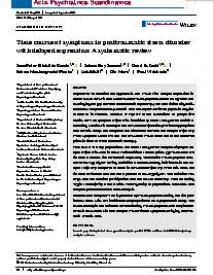Time course of symptoms in posttraumatic stress disorder with delayed expression : a systematic review
Objective
to examine the hypothesis that PTSD with delayed expression in some cases occur without subthreshold PTSD symptoms above background levels bridging the gap between the traumatic exposure(s) and the clinical diagnosis.
Methods
We performed systematic searches of peer-reviewed papers in English referenced in Pubmed, Embase or PsycINFO and ascertained 34 prospective studies of PTSD symptom trajectories identified by latent class growth statistical modeling. Studies with delayed and low-stable trajectories provided appropriate data for this study. We computed the difference between the delayed trajectory PTSD symptom sumscore and the low-stable PTSD sumscore at the observed points in time after the traumatic event(s).
Results
In 29 study populations, the latent class growth analyses displayed delayed trajectories and in these, we identified 110 data points (% PTSD sumscore difference/months since traumatic exposure). The median PTSD symptom sumscore was 25% higher during the initial 6 months among individuals in the delayed trajectory compared to those in low stable trajectory. From this level, the difference widened and reached a plateau of 40-50% higher. The variation was large, and the baseline participation rate and loss to follow-up was exceeding 25% in the majority of the studies. Heterogeneity of populations, measures and analyses precluded formal meta-analysis.
Conclusion
delayed PTSD is preceded by PTSD symptoms during the first year in most cases. Still, few individuals may experience an asymptomatic delay. The results underpin the rationale for monitoring PTSD symptoms and may inform forensic assessments in that delayed PTSD without symptoms bridging the traumatic event is rare.
In: Acta Psychiatrica Scandinavica ; ISSN: 1600-0447 | 145 | 2 | february | 116-131
https://doi.org/10.1111/acps.13372


